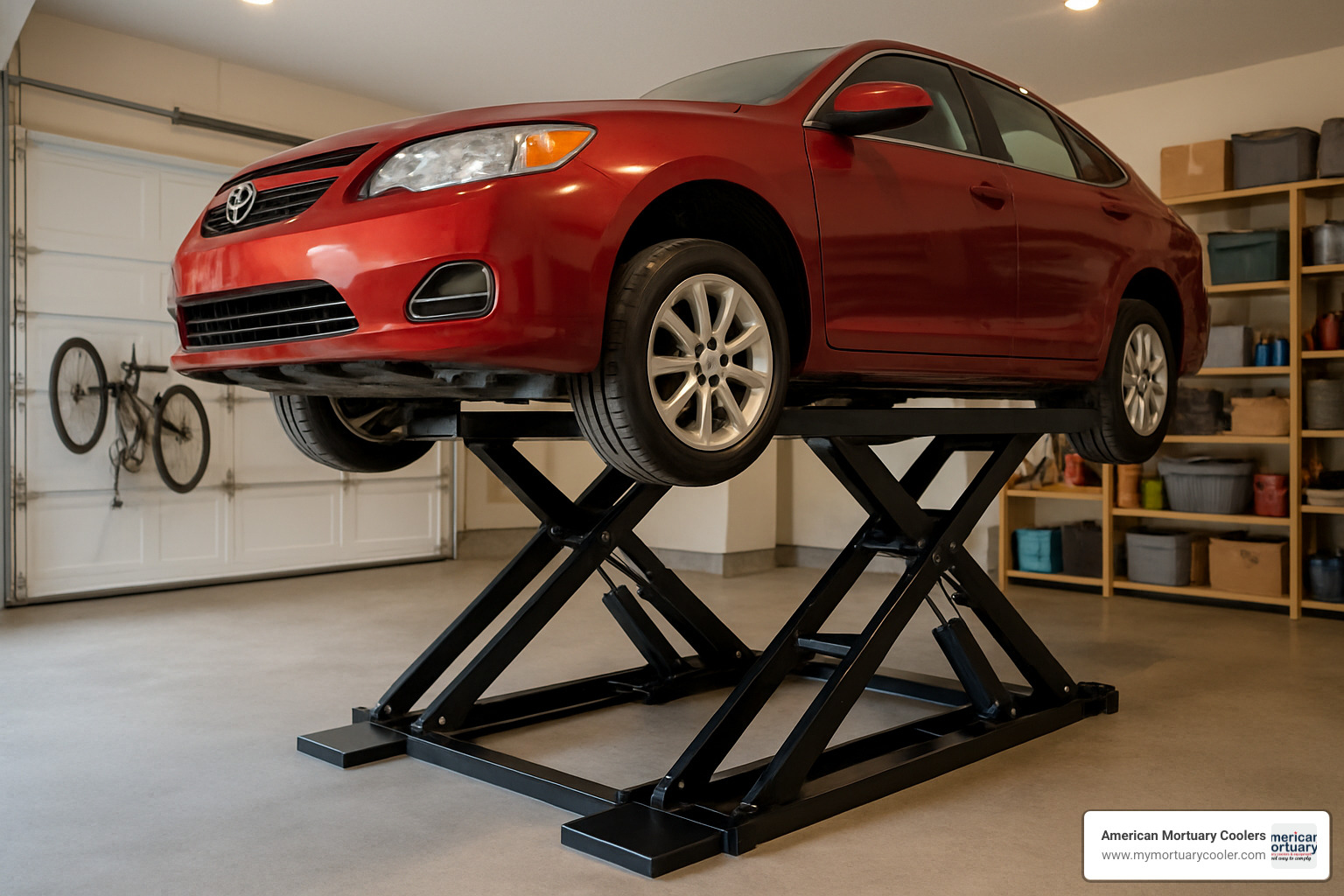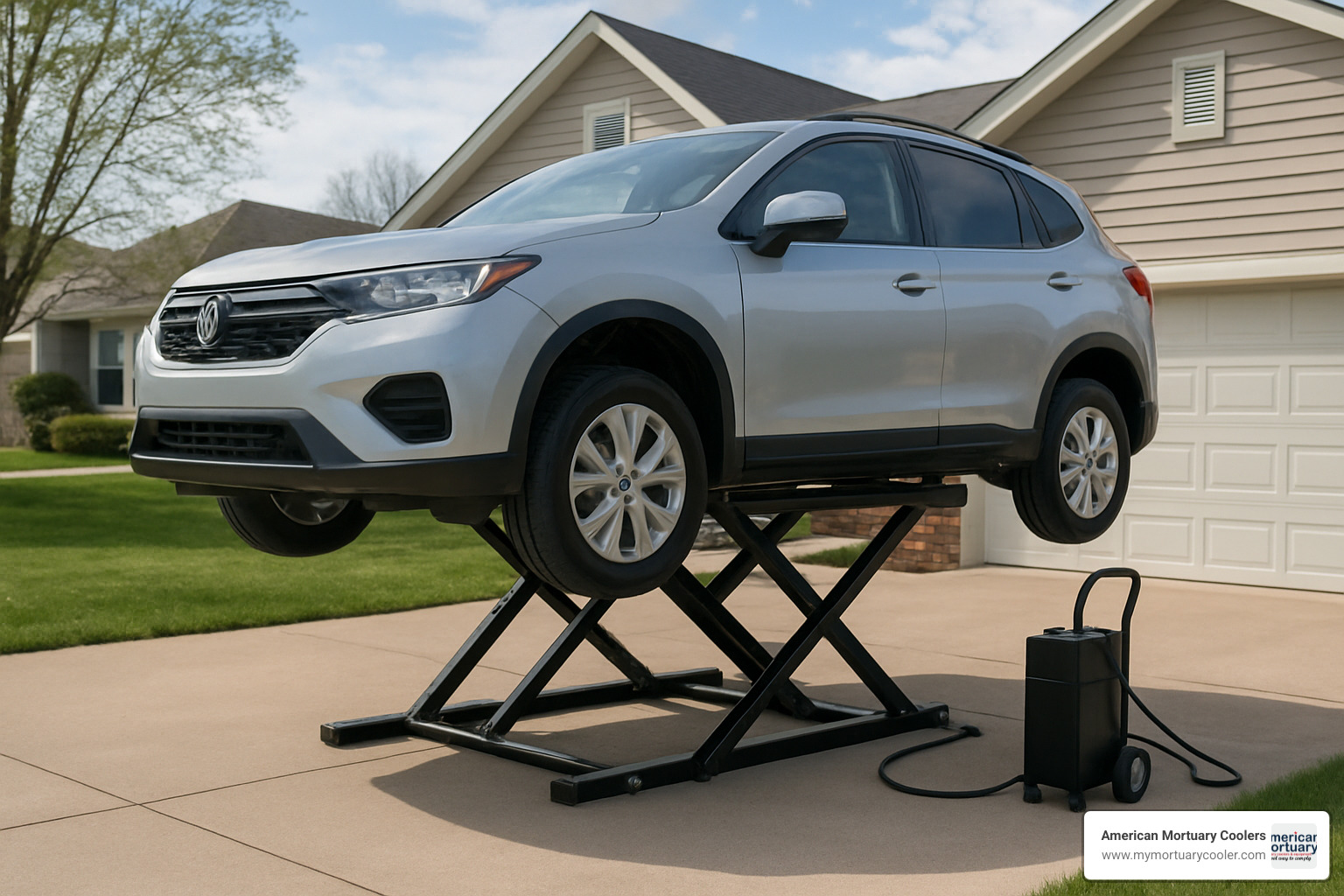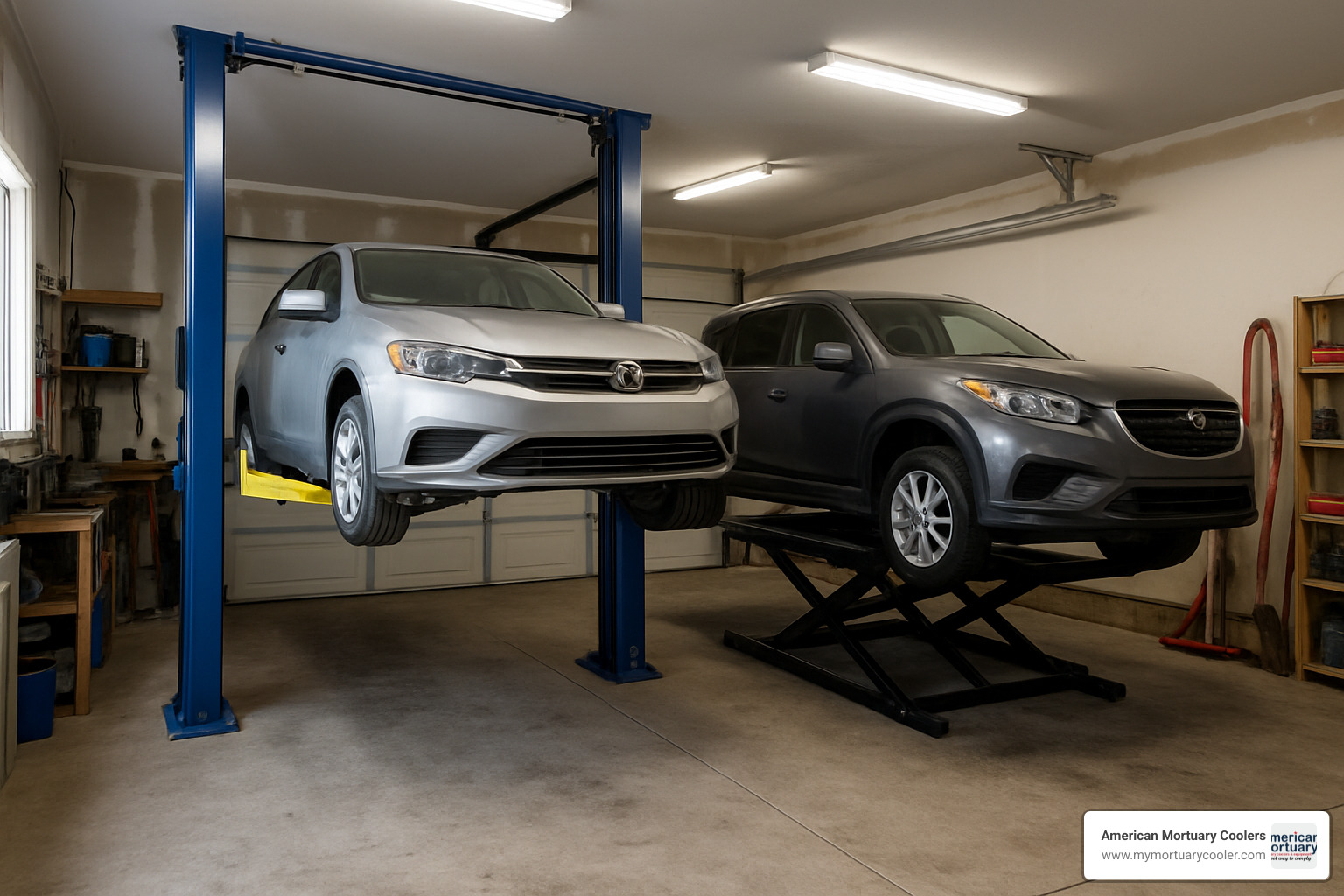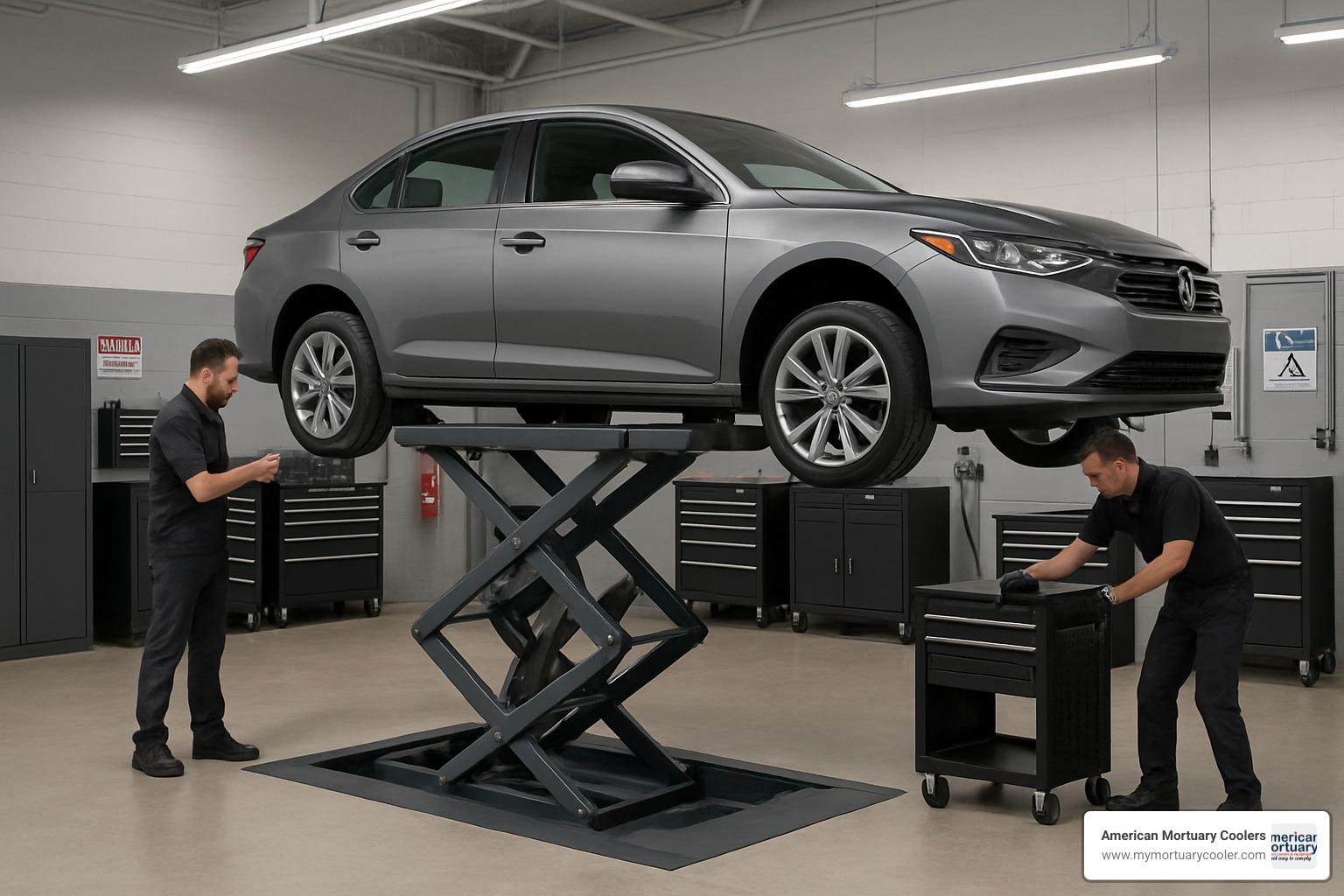Why Scissor Car Lifts Are Changing Home Garages
A scissor car lift is a hydraulic vehicle lifting system that uses a scissor-like mechanism to raise cars for maintenance, repairs, and inspections. Here's what you need to know:
Key Features:
- Capacity: 3,300 to 16,000 lbs
- Lift Height: 43-78 inches depending on type
- Types: Mid-rise, full-rise, portable, and alignment models
- Power: 110V, 220V electric, or pneumatic
- Price Range: $2,199 to $32,999
Main Benefits:
- Compact footprint fits tight spaces
- Works in garages with low ceilings
- Open-center design for easy access
- Portable models move between jobs
- Safer than jack stands
If you're tired of crawling under your car with jack stands, you're not alone. One forum user put it perfectly: "I've got two-post and four-post lifts in my garage but hate crawling under cars for oil changes—could a scissor lift save me time and effort?"
The answer is yes. Scissor lifts solve the biggest pain points of floor jacks and stands - they're unstable, time-consuming to set up, and force you to work in uncomfortable positions.
Whether you're a weekend DIY mechanic or run a professional shop, scissor lifts offer the perfect balance of safety, convenience, and space efficiency. They're especially popular in home garages where ceiling height limits your options.
This guide will walk you through everything you need to know - from understanding the different types to choosing the right model for your specific needs and budget.
I'm Mortuary Cooler, and while I specialize in mortuary equipment, I've worked extensively with hydraulic lifting systems including scissor car lift technology for over a decade. My experience with precision lifting equipment in demanding environments gives me unique insight into what makes these systems reliable and safe.

Scissor car lift vocab explained:
What Is a Scissor Car Lift? Operation, Types & Specs
Think of a scissor car lift as the Swiss Army knife of garage equipment. The magic happens with those crossed metal arms that look just like a giant pair of scissors. When hydraulic cylinders push these arms together at their pivot points, your car rises smoothly and steadily into the air.
What makes these lifts so appealing is their clever engineering. While a two-post lift might hog half your garage and demand sky-high ceilings, a scissor lift can collapse down to just 7.5 inches tall and tuck away in surprisingly tight spaces. It's like having a professional shop lift that knows how to mind its manners in a home garage.
The real beauty shows when you need to work. Unlike wrestling with jack stands that always seem to be in the wrong spot, scissor lifts give you clean, stable access to your vehicle's underside.

What Is a Scissor Car Lift?
A scissor car lift is essentially a parallelogram frame powered by dual hydraulic cylinders that create perfectly balanced lifting action. The engineering is straightforward but effective.
The scissor arms are the heavy-duty steel backbone of the system. These cross in that familiar X-pattern, distributing weight evenly as they extend upward. Hydraulic cylinders - typically two for balance - provide the muscle, while safety locks automatically click into place at multiple positions. Think of these locks as your insurance policy - even if something goes wrong with the hydraulics, your car stays put.
The platform pads adjust to fit different vehicle types, from low sports cars to high-riding trucks. And the power unit - whether electric or pneumatic - keeps everything running smoothly.
Here's how it works: hydraulic pressure pushes the cylinders outward, which forces the scissor arms to extend vertically. The platform rises in a perfectly controlled motion, and those safety locks engage automatically at preset intervals. It's simple physics doing heavy lifting.
Main Types of Scissor Car Lifts
Choosing the right type of scissor car lift depends on your space, ceiling height, and what kind of work you're planning.
Mid-rise scissor lifts are the garage favorites for good reason. They lift your vehicle 43 to 52 inches high - perfect for oil changes, brake work, and most routine maintenance. They're also ceiling-friendly, working fine in garages with standard 8-foot heights. If you're doing weekend warrior car care, this is probably your sweet spot.
Full-rise scissor lifts are the heavy hitters, reaching up to 78 inches high. The Atlas SLP9K is a great example - it handles 9,000 pounds and gives you full walk-under clearance for major repairs. These are more common in professional shops where you need serious working room.
Low-rise scissor lifts keep things minimal but maximize portability. They're perfect for tire rotations and quick inspections when you just need a few inches of clearance.
Portable scissor lifts sound great in theory - wheels and mobility for moving between jobs. But here's the reality check: even "portable" scissor lifts are heavy beasts that often need mechanical help to move around. Don't expect to wheel them around like a shopping cart.
Alignment scissor lifts come with built-in turntables and specialized features for precise wheel alignment work. And flush-mount scissor lifts disappear into your floor when not in use, creating a completely clean workspace.

Typical Capacities & Lift Heights
Scissor car lifts come in a wide range of capacities, from 3,300 pounds for compact cars all the way up to 16,000 pounds for heavy-duty commercial vehicles. This flexibility means there's likely a perfect match for whatever you're driving.
For light-duty work with compact cars and sedans, look at the 3,300 to 6,000-pound range. The popular Amgo MR06 fits here perfectly with its 6,000-pound capacity and 43-inch lift height - ideal for most home garage needs.
Medium-duty lifts handling 6,000 to 9,000 pounds work well with SUVs and light trucks. The Katool KT-X85 exemplifies this category with 8,000-pound capacity and 48-inch lift height. For many homeowners with modern vehicles, this hits the sweet spot.
Heavy-duty options from 10,000 to 16,000 pounds tackle commercial vehicles and heavy trucks. These are serious pieces of equipment for serious work.
When it comes to lift heights, mid-rise models typically reach 43 to 52 inches - enough clearance for most maintenance tasks without requiring excessive ceiling height. The BendPak MDS-6EXT stretches this category with its 52-inch maximum height.
Full-rise models like the Atlas SLP9K reach up to 78 inches, giving you true walk-under clearance for major repairs. And when not in use, most scissor lifts collapse to a remarkably slim 7.5-inch profile.
The key is matching capacity and height to your specific needs. A 6,000-pound lift might handle your sedan perfectly, but if you're planning to work on your neighbor's truck too, stepping up to 8,000 or 9,000 pounds gives you that extra safety margin and versatility.
Scissor Car Lift vs Other Lift Styles
Choosing the right lift for your garage can feel overwhelming with so many options available. Let's break down how scissor car lifts stack up against other popular lifting solutions, so you can make the best choice for your specific needs and space.
When comparing lift styles, you'll typically consider two-post lifts, four-post lifts, QuickJack systems, drive-on ramps, and pit lifts. Each has its place, but they all come with different trade-offs in terms of footprint, ceiling height requirements, and workflow speed.

The image above perfectly illustrates the space difference between a traditional two-post lift and a scissor car lift. Notice how much more floor space the two-post system requires, while the scissor lift keeps a much smaller footprint.
Advantages of Scissor Car Lifts
Small footprint is where scissor lifts truly shine. If you're working in a tight garage, this matters more than you might think. As noted in our research, "Scissor lifts are favored in shops with low ceilings and limited space, as their compact design allows for installation in areas where two-post or four-post lifts may not fit."
Portability sets many scissor lifts apart from fixed installations. While you shouldn't expect to move a 2,000-pound lift by hand, many models include wheels or can be repositioned with proper equipment. This flexibility is something you'll never get with permanently installed post lifts.
Low-ceiling friendly design makes scissor lifts perfect for residential garages. With mid-rise models requiring only 8-10 feet of ceiling height, they work in spaces where two-post lifts simply won't fit. Most home garages have 8-9 foot ceilings, making this a crucial advantage.
Open-center access gives you unobstructed reach to the entire undercarriage. Unlike four-post lifts where the runway gets in your way, scissor lifts provide clear access for exhaust work, oil changes, and transmission repairs. You can walk around the entire vehicle without obstacles.
Fast setup means you can be working in minutes rather than hours. Most scissor lifts position quickly and don't require the permanent installation that post lifts demand. This matters whether you're a weekend warrior or running a busy shop.
Disadvantages and Limitations
Reduced undercarriage reach is the biggest limitation of mid-rise models. Those 43-52 inch lift heights don't provide full walk-under clearance. As one forum user honestly noted, "Mid-rise lifts (~4 ft) do not fully clear the chassis for oil-pan work." You'll still be working at an angle for some tasks.
Pad placement precision requires more attention than post lifts. While two-post and four-post lifts use adjustable arm assemblies, scissor lifts need precise positioning of lifting pads on your vehicle's designated lift points. Get it wrong, and you risk damage.
Height limits even on full-rise models max out around 78 inches. That's less than many two-post lifts can achieve, which might matter if you need maximum clearance for major repairs or inspections.
Higher price than basic solutions puts scissor lifts in a different category from jack stands or drive-on ramps. Quality scissor car lifts start around $2,199, while a good set of jack stands costs under $100. The investment makes sense if you value safety and convenience, but it's definitely a bigger upfront cost.
The bottom line? Scissor lifts work best when you need the perfect balance of safety, space efficiency, and accessibility. They're not the cheapest option, and they're not the highest-lifting option, but they might be the smartest option for your specific situation.
Buying, Installing & Maintaining Your Scissor Car Lift
Choosing the right scissor car lift involves balancing capacity, features, and budget. Let's break down what matters most.
Key Features to Look For
Safety Features: Look for multiple safety lock positions and dual hydraulic cylinders. All quality lifts should meet ANSI/ALI ALCTV standards - you can verify this at Scientific research on lift safety.
Portability Options: Wheels or compact frames matter if you need to reposition the lift frequently. However, even "portable" units can weigh 400-900 kg.
Power Source Flexibility: Choose between 110V (convenient for home use), 220V (faster operation), or pneumatic (quiet operation). Match your garage's available power.
Platform Design: Open-center designs provide better access than solid platforms. Adjustable pad adapters accommodate different vehicle types.
Auto-Lock Positions: Quality lifts offer multiple locking positions with pneumatic or electric release systems for safety and convenience.
Space & Installation Requirements
Garage Footprint: Most scissor lifts require 8-12 feet of length and 6-8 feet of width when fully extended. Measure your available space carefully.
Ceiling Height: Mid-rise lifts work with 8-10 foot ceilings, while full-rise models need 12+ feet for maximum effectiveness.
Floor Requirements: Concrete floors should be 4-6 inches thick for surface-mounted units. Flush-mount installations require cutting and reinforcing the floor.
Electrical Needs:
- 110V models: Standard household current, slower operation
- 220V models: Faster lifting, may require electrical upgrades
- Pneumatic models: Need 90-110 psi air supply
Installation Options: Surface mount (sits on top of floor) or flush mount (recessed into floor). Flush mounting saves space but requires more complex installation.
Top Brands, Models & Pricing
Based on our research and industry experience, here are the standout options:
Budget Champion - Amgo MR06: At $2,199, this 6,000 lb capacity, 43-inch lift height model offers excellent value for basic home use.
Best Overall - Katool KT-X85: The 8,000 lb capacity with 48-inch lift height provides the sweet spot of power and versatility for serious home mechanics.
Professional Grade - BendPak MDS-6EXT: With 52-inch lift height and proven reliability, it's worth the premium for frequent use. Check the MDS-6LP mid-rise certification for safety verification.
Heavy-Duty Champion - Atlas SLP9K: For professional shops needing 9,000 lb capacity and 78-inch full-rise capability.
Price Factors:
- Entry-level mid-rise: $2,199-$3,500
- Premium mid-rise: $3,500-$8,000
- Full-rise professional: $8,000-$32,999
- Installation adds: $500-$2,000 depending on complexity
For more detailed comparisons, check out our More info about auto scissor lift selection.

Maintenance & Care Tips
Proper maintenance ensures safety and longevity. Here's our recommended schedule:
Daily Visual Inspection: Check for hydraulic leaks, damaged cables, and proper pad positioning before each use.
Weekly Lubrication: Grease all pivot points and moving parts. Use marine-grade lubricant in humid environments.
Monthly Hydraulic Check: Verify fluid levels and test all safety locks. Look for signs of contamination or air in the system.
Annual Professional Inspection: Have an ALI-certified technician perform comprehensive safety inspection. This isn't just good practice - it's often required for insurance coverage.
Rust Prevention: Apply protective coatings to exposed metal, especially if the lift sees road salt exposure. As one user shared, "Exposed ramps may rust over years; routine repainting and coatings mitigate corrosion."
Frequently Asked Questions about Scissor Car Lifts
Is a scissor car lift safe to use?
Yes, scissor car lifts are remarkably safe when you follow basic safety practices. I've seen these systems in action for years, and the safety features are impressive.
Modern lifts come with multiple safety locks that automatically click into place as the lift rises. Even if you lose hydraulic pressure completely, these mechanical locks keep your vehicle secure. Quality lifts also feature dual hydraulic cylinders - if one fails, the other maintains control.
Look for ALI certification when shopping. This means the lift meets strict ANSI/ALI ALCTV-2017 safety standards and has been tested to 150% of its rated capacity. That's a serious safety margin.
The real safety comes down to you, though. Always engage those safety locks before working under a vehicle. Never exceed the weight limit. And stick to your maintenance schedule - a well-maintained lift is a safe lift.
How much space do I need in my garage?
Here's the reality check most people need: you'll want more space than you think.
Your garage needs to be at least 12-16 feet long to accommodate both the lift and your vehicle with some breathing room. Width-wise, plan for 8-10 feet minimum - this gives you comfortable working space around the lift without bumping into walls.
Ceiling height is crucial. Mid-rise lifts work fine with 8-foot ceilings, but you'll appreciate having 9-10 feet. Full-rise models really need 12+ feet to be worthwhile.
Don't forget about door swing space around the lift. You need room to open car doors and move around safely. I always tell people to measure their largest vehicle first, then add 2-3 feet on all sides.
One thing many folks overlook: consider how you'll get the lift into your garage. Some models break down for delivery, others don't.
Is a scissor car lift worth the investment for home use?
For serious DIY mechanics, absolutely. Let me break down the math that makes sense.
Time savings alone justify the cost for many people. Oil changes that used to take 45 minutes with jack stands now take 15 minutes. No more crawling around on cold concrete, wrestling with safety stands, or worrying about stability.
The safety value is huge. Jack failures cause real injuries in home garages. A quality scissor car lift eliminates that risk entirely.
From a financial perspective, if you're doing 6+ oil changes per year plus other maintenance, the convenience and time savings pay for themselves within 2-3 years. Quality lifts also hold their value well - expect to recover 60-70% if you ever sell.
One customer told me recently: "Best garage upgrade I ever made. Turns oil changes from a dreaded chore into a quick task." That's the kind of feedback I hear regularly.
The investment makes less sense if you only work on cars occasionally or prefer taking everything to a shop. But for hands-on car enthusiasts, it's often a game-changer.
Conclusion
Choosing the right scissor car lift comes down to understanding your specific needs and finding that sweet spot between capacity, height, and your budget. After diving deep into scissor lifts, here's what really matters:
Safety should always be your top priority. Don't cut corners here - always choose ALI-certified lifts with multiple safety locks and proven track records. That few hundred dollars you might save on a cheaper lift simply isn't worth the risk to your safety or your vehicle.
Get the capacity right from the start. Take your heaviest vehicle's weight and add a 20% safety margin. If your truck weighs 6,000 lbs, you need at least a 7,200 lb capacity lift. It's better to have too much capacity than not enough.
Your garage space will dictate your options. Most home garages work perfectly with mid-rise lifts that reach 43-52 inches - enough height for most maintenance tasks without needing a cathedral ceiling. If you have the ceiling height for a full-rise model that reaches 78 inches, you'll get that coveted walk-under access for major repairs.
Don't forget to budget for installation costs. Between electrical work, concrete anchoring, and professional setup, you're typically looking at an additional $500-$2,000. Factor this into your decision from the beginning.
At American Mortuary Coolers, we understand the importance of reliable lifting equipment. While we specialize in custom mortuary coolers and funeral industry equipment, our experience with precision hydraulic systems across our locations from Tennessee to California has given us deep appreciation for quality engineering and safety standards.
Our top picks based on real-world performance: The Amgo MR06 at $2,199 offers unbeatable value for budget-conscious home mechanics. The Katool KT-X85 at $3,599 hits the sweet spot for most serious DIYers. Professional shops should consider the BendPak MDS-6EXT starting around $6,800, while heavy-duty operations need the Atlas SLP9K at $18,000+.
Here's the truth: a quality scissor car lift is a long-term investment that pays dividends for years. Buy once, maintain it properly, and you'll enjoy decades of safe, convenient vehicle service. Never skip those annual safety inspections, and always follow the manufacturer's maintenance schedule.
Ready to make your final decision? Our comprehensive More info about scissor lift buying guide offers additional insights and recommendations to help you choose with confidence.
Your back will thank you for ditching those jack stands, your efficiency will skyrocket, and your garage will become the envy of every car enthusiast in the neighborhood. That's a pretty good return on investment.
















